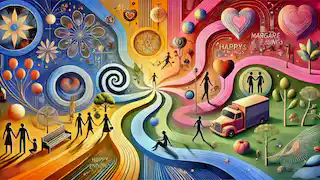"Happy Endings" by Margaret Atwood is a well-known short story that explores multiple narrative possibilities for a couple's life together. The story presents a series of scenarios, labeled A through F, each depicting different events that can occur in the lives of two characters, John and Mary. Each scenario ends with a version of "happily ever after" — but with a twist, as Atwood cleverly questions the meaning and purpose of traditional happy endings in fiction. The story is a sharp critique of narrative conventions and the illusion of predictable, tidy resolutions. The real heart of the story lies not in how things end but in how they unfold, asking us to think critically about what really matters in storytelling and in life. John and Mary meet. They fall in love. They get married. They both have worthwhile and remunerative jobs which they find stimulating and challenging. They buy a charming house. Real estate values go up. Eventually, when they can afford live-in help, they have two children, to whom they are devoted. The children turn out well. John and Mary have a stimulating and challenging sex life and worthwhile friends. They go on fun vacations together. They retire. They both have hobbies which they find stimulating and challenging. Eventually, they die. This is the end of the story. Mary falls in love with John, but John doesn't fall in love with Mary. He merely uses her body for selfish pleasure and ego gratification of a tepid kind. He comes to her apartment twice a week and she cooks him dinner, though she doesn't care much for cooking, and she does everything she thinks he likes in bed. She's convinced that if she does everything right, he will fall in love with her and they will live happily ever after. John tells her he wants her but he doesn't love her and he already has someone else named Madge. Mary decides she has to make John love her, but nothing works. Finally, she takes an overdose of sleeping pills and dies. John marries Madge and everything proceeds as in A. John is an older man. He falls in love with Mary, who is twenty-two. Mary is only moderately interested in him. She sleeps with him because he offers her something: a job, maybe a nice apartment, or because she feels sorry for him. Maybe she likes the way he smells. Maybe she uses him to get over an old boyfriend. Maybe she has no reason at all for doing it; one night, she's feeling bored or lonely or just curious. She doesn't know what she wants, but she knows she doesn't want John. John realizes that, but he won't accept it. John becomes obsessive. He tries to make her love him by buying her gifts, writing her letters, following her. Mary feels increasingly trapped. She tries to break it off, but John won't listen. Eventually, John kills Mary and himself because he can't stand living without her. Madge, John's wife, marries someone else and everything proceeds as in A. Fred and Madge have problems, but they keep busy. They buy a house, they buy a car, they have two kids. The kids turn out okay. Fred works in an office and Madge works in a different office. They have sex once a week, though they both pretend to be more enthusiastic about it than they really are. Fred develops heart trouble and becomes listless, grumpy, dissatisfied. Madge copes with this by enrolling in an aerobics class and taking up gardening. Eventually, Fred dies, leaving Madge to carry on alone. She meets a man named John and marries him. Everything proceeds as in A. The story continues as before but with political context. Civil unrest develops in the society. John and Mary work as revolutionaries, fighting against the oppressive government. The country faces a growing crisis, and their relationship suffers under the pressure. Eventually, their revolution succeeds, but Mary dies in the conflict. John, disillusioned and heartbroken, marries Madge. They retire together, live comfortably, and everything proceeds as in A. {{{_03}}} None of the above. It's about how things begin, not how they end. John and Mary can be anyone, living in any era, in any situation. The important part isn't whether they marry, live happily, or meet tragic ends. The important part is what happens between the beginning and the end, how they make choices, how they live their lives. The only true ending is this: "John and Mary die." All stories end the same way, but what makes them interesting is how they get there. Life is about the journey, the process, not the destination. "Happy Endings" is a metafictional story, intentionally subverting the traditional structure of a narrative. Atwood cleverly dismisses the significance of happy endings, forcing the reader to reflect on how stories are written and consumed. Each scenario, though vastly different in plot, circles back to the same conclusion — a recognition of life's inevitability and the futility of clinging to a single, perfect outcome. Atwood uses dry humor and matter-of-fact prose to drive home the point that the intrigue of a story isn't in how it ends, but in how it develops. "Happy Endings" is a brilliantly crafted piece that challenges the reader to think critically about narrative expectations. Atwood strips away the superficial aspects of storytelling to reveal the truth that no matter how different the paths, every story ends the same way. What matters is how you tell it, what happens along the way, and the choices characters make to shape their lives.Scenario A:

Scenario B:
Scenario C:

Scenario D:
Scenario E:
Scenario F:
Analysis:

Conclusion:
Happy Endings by Margaret Atwood
Reading Time: 5 min

About Story: Happy Endings by Margaret Atwood is a Realistic Fiction Stories from set in the Contemporary Stories. This Humorous Stories tale explores themes of Romance Stories and is suitable for Adults Stories. It offers Entertaining Stories insights. Multiple paths, one inevitable end.


















